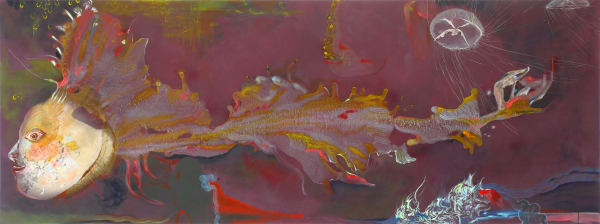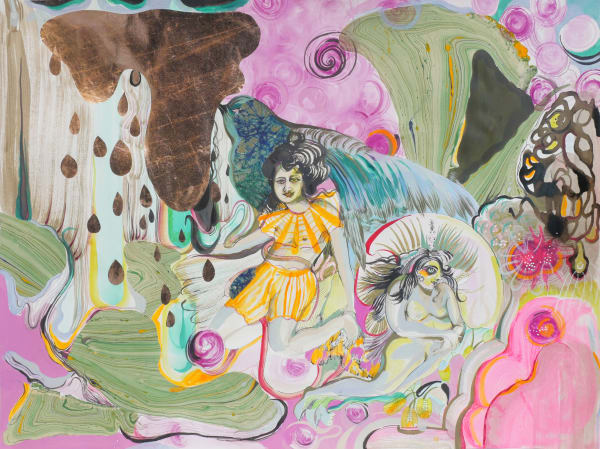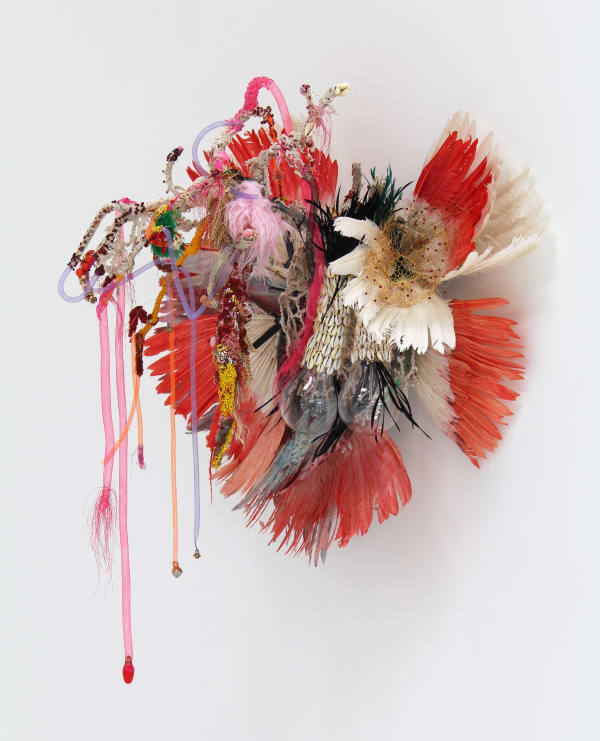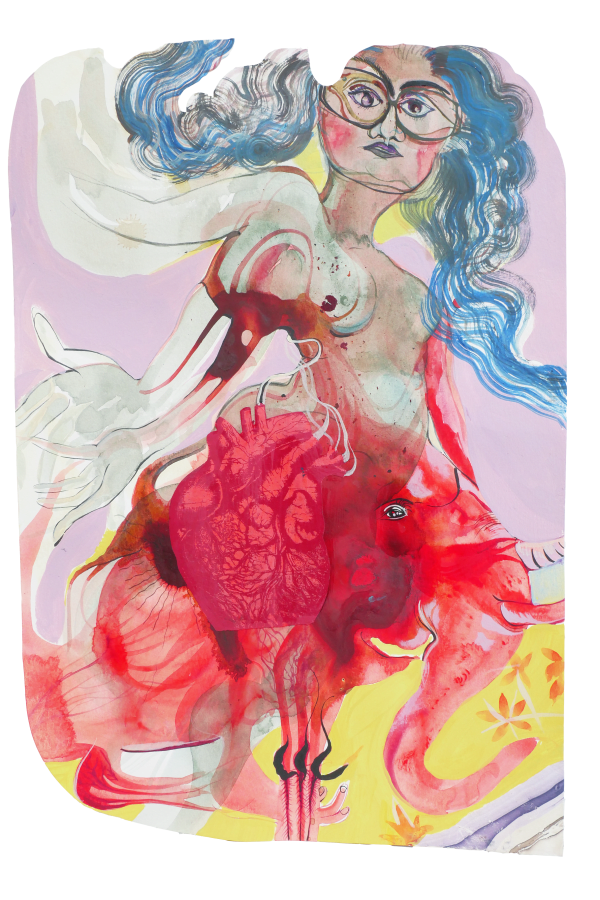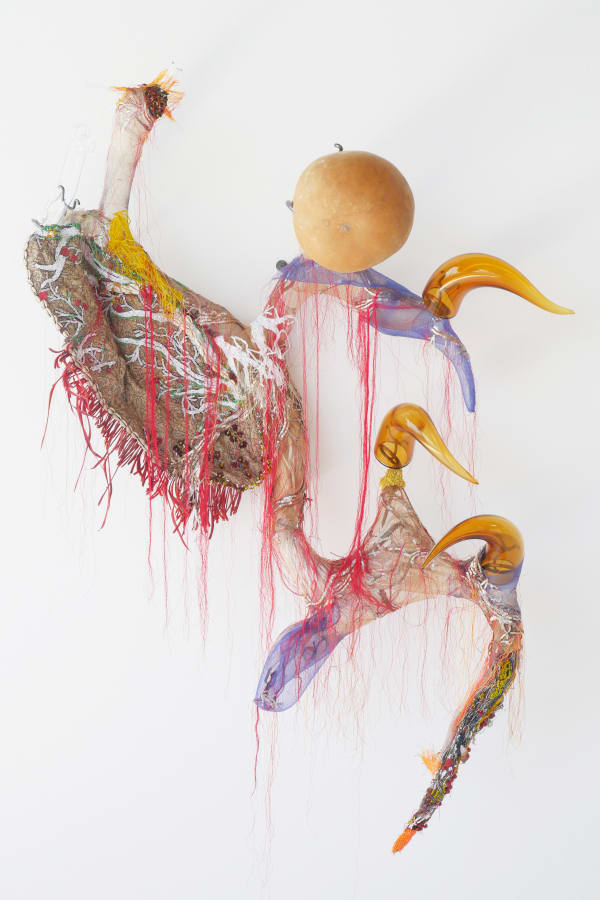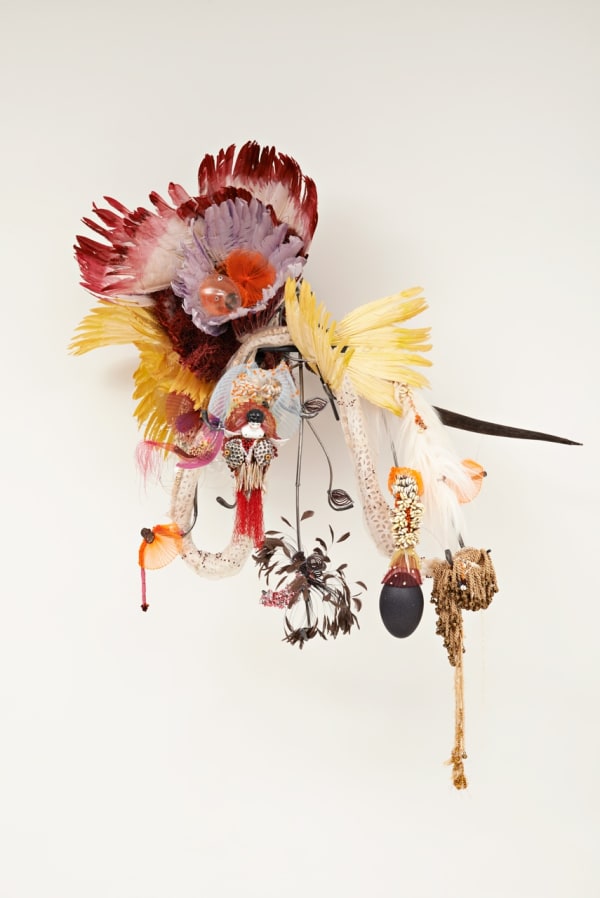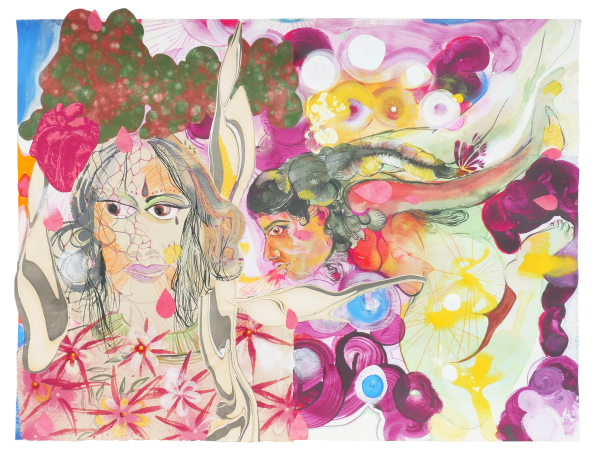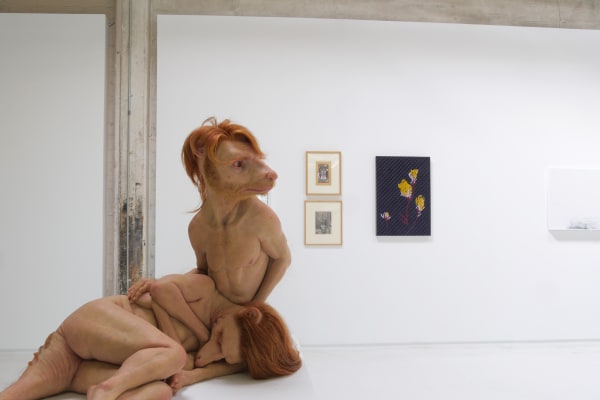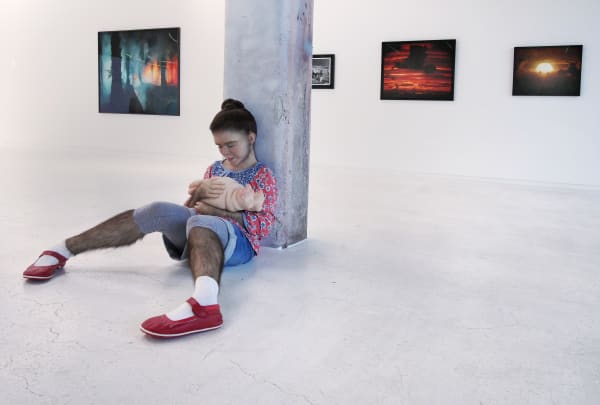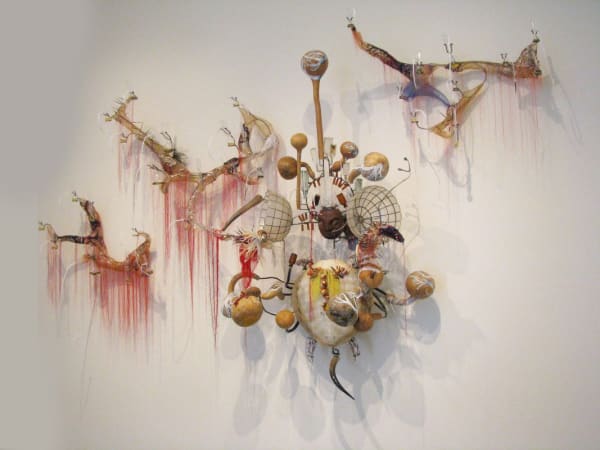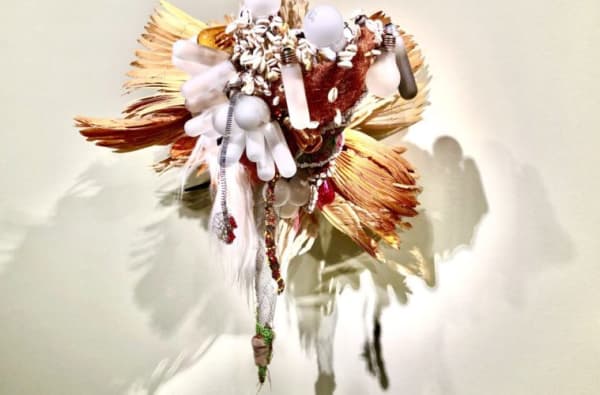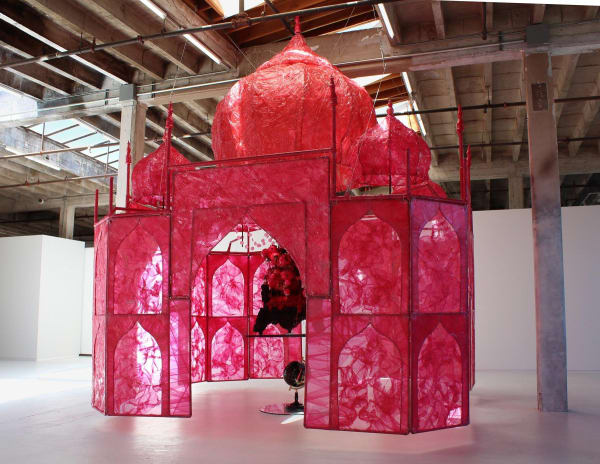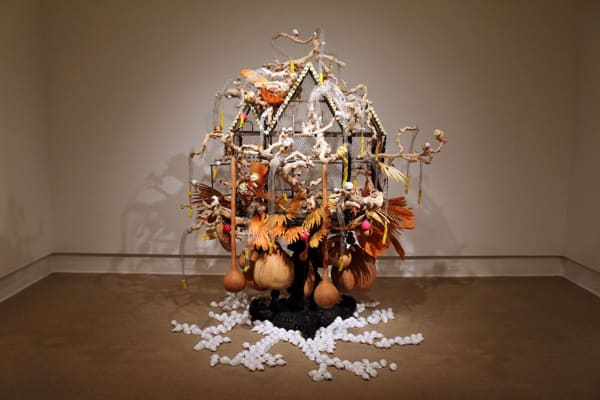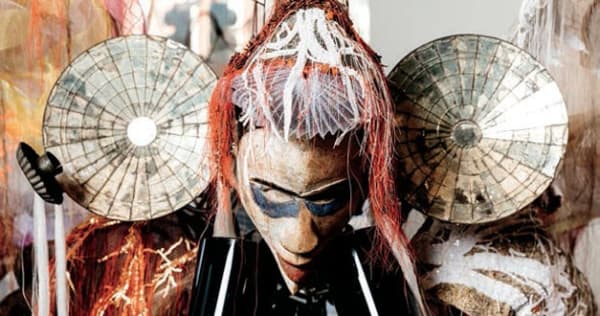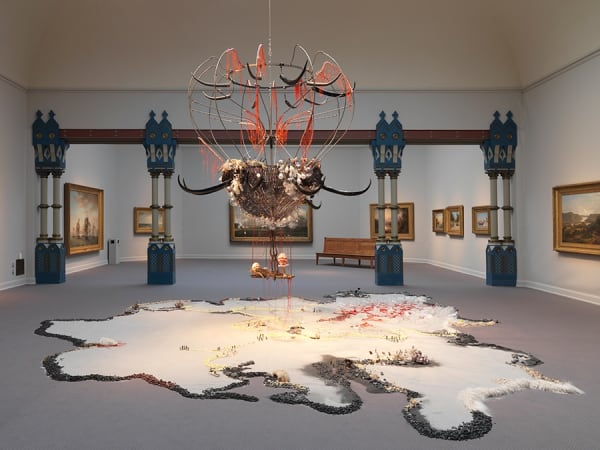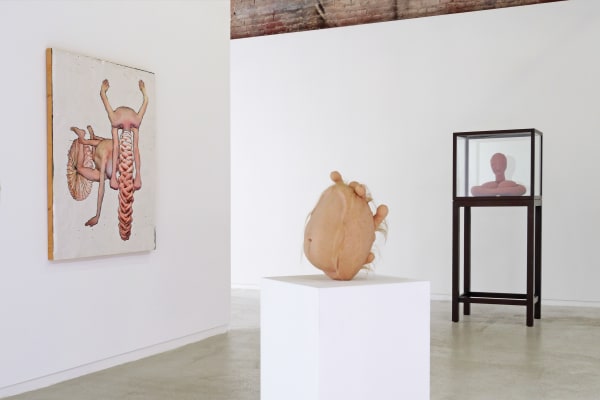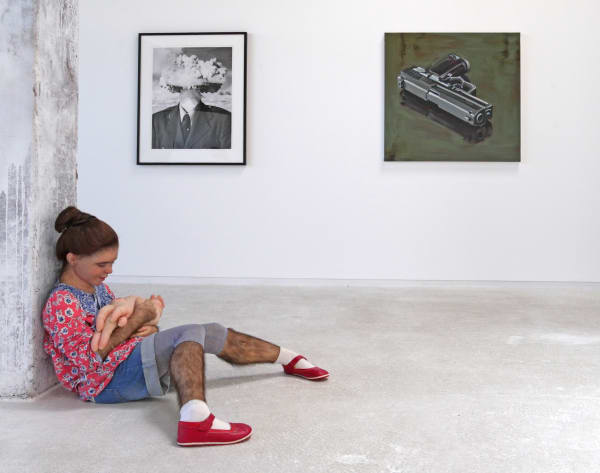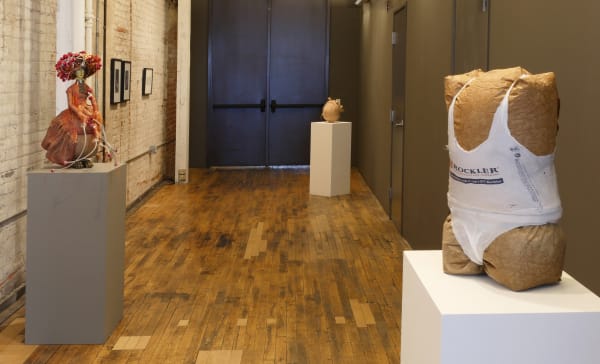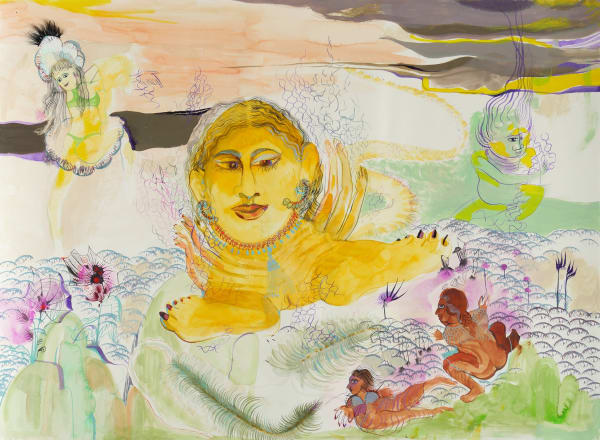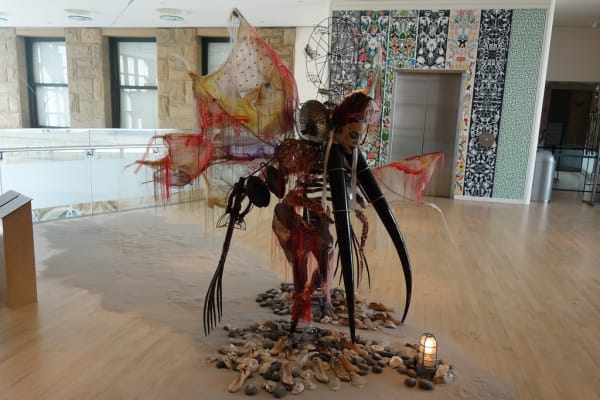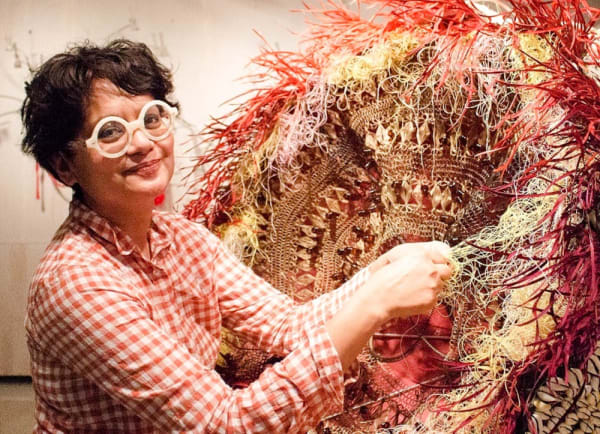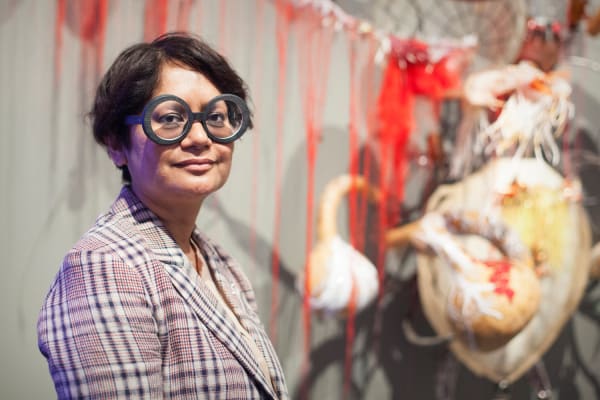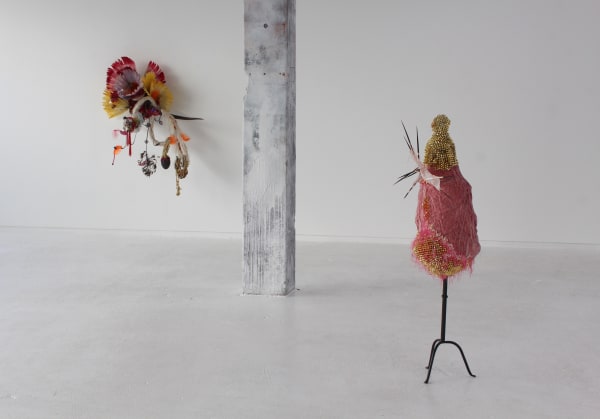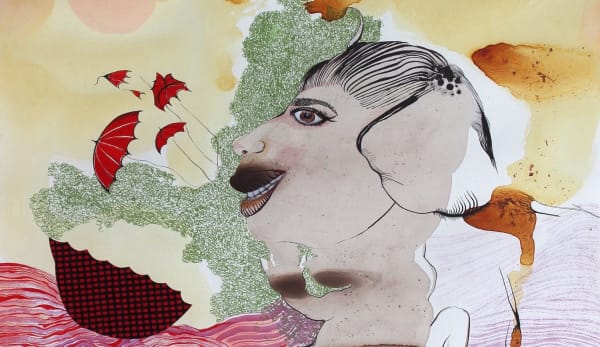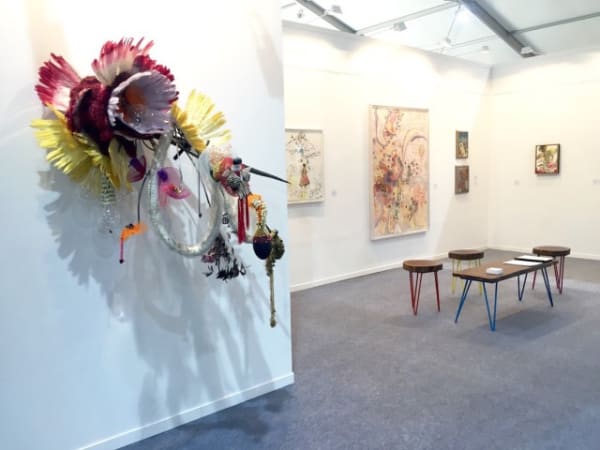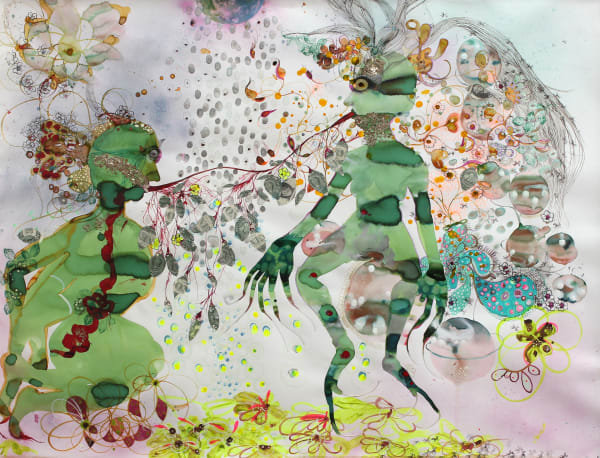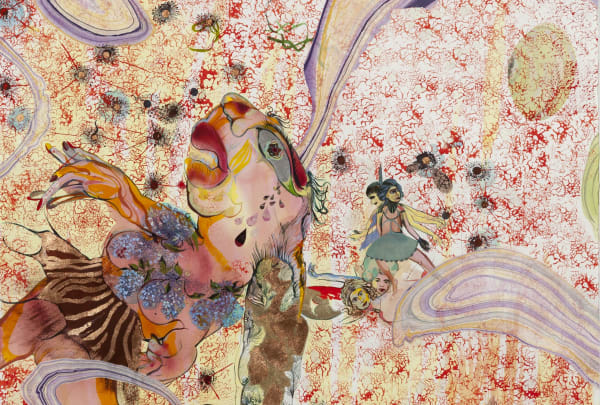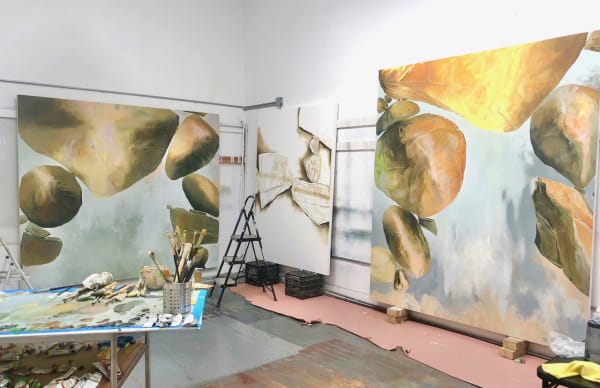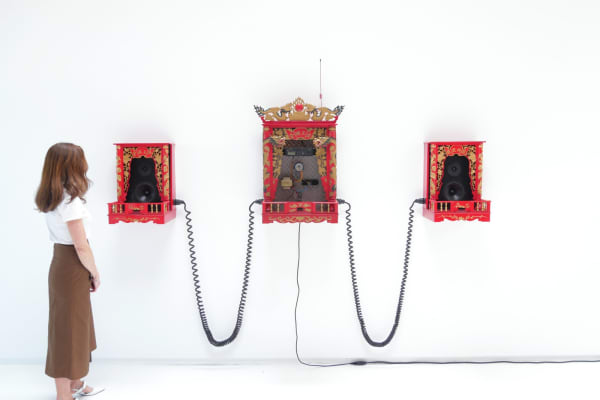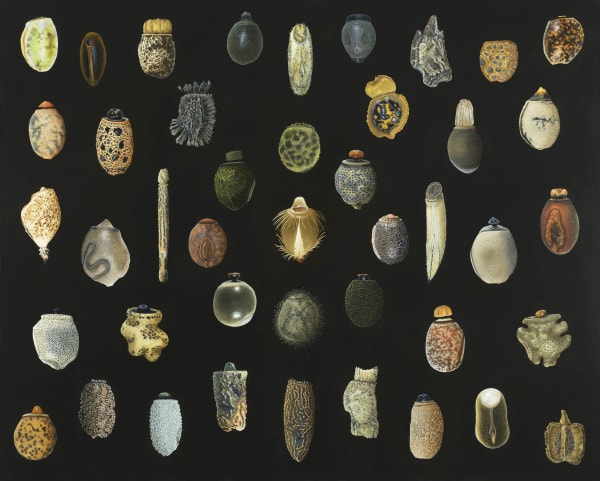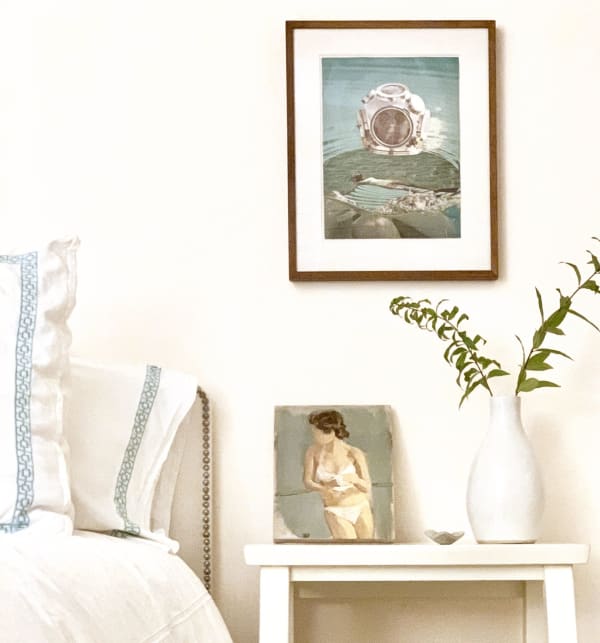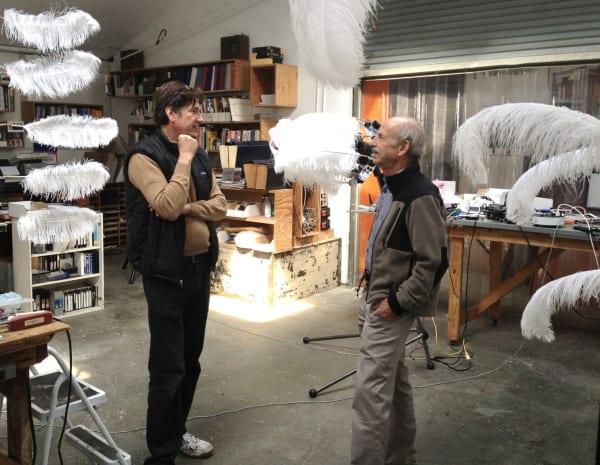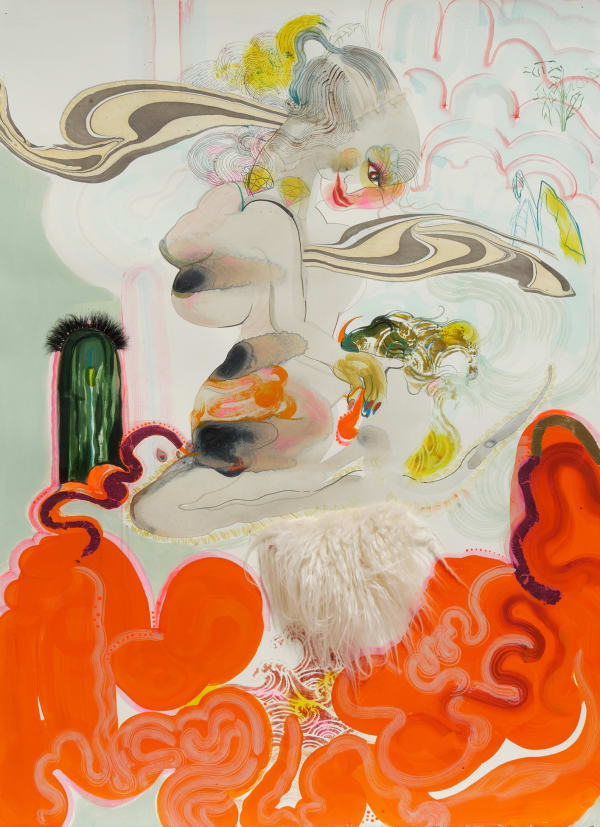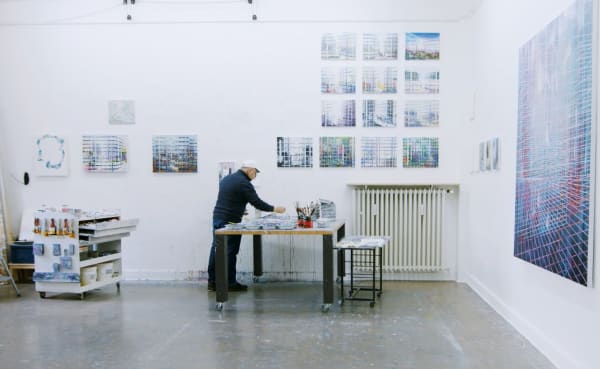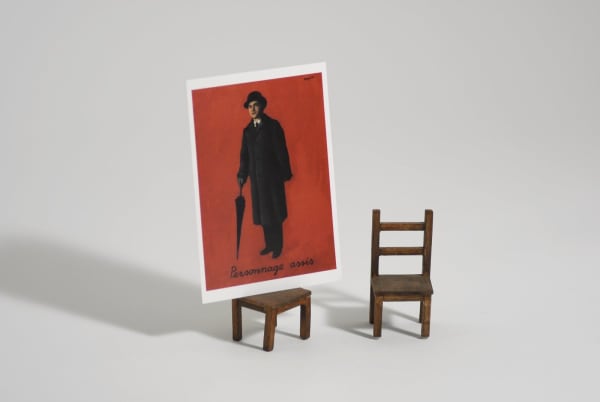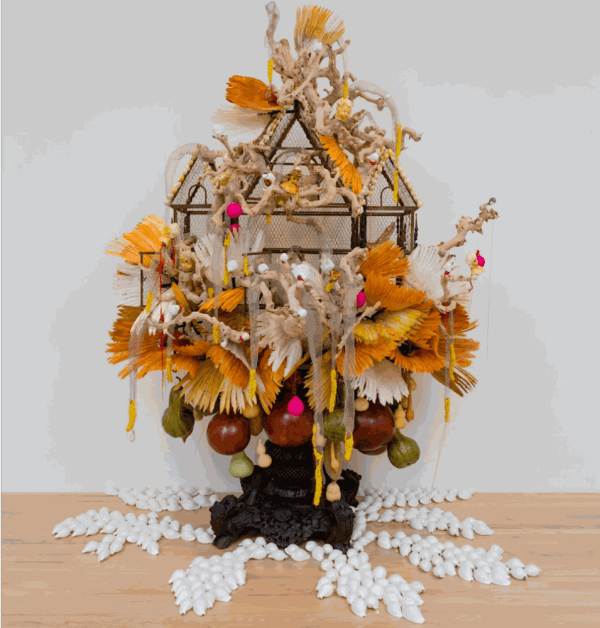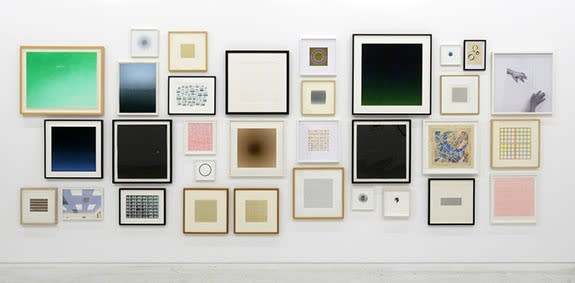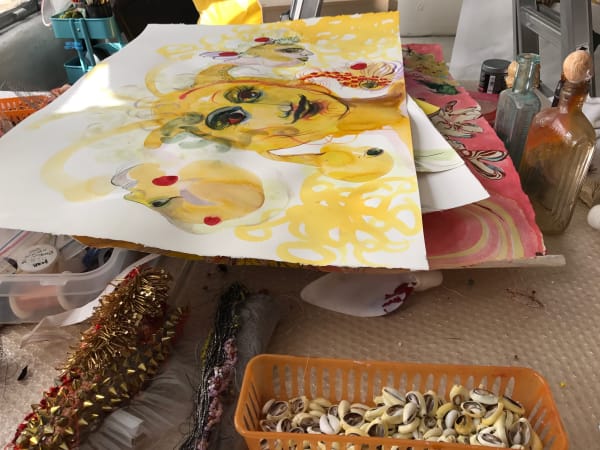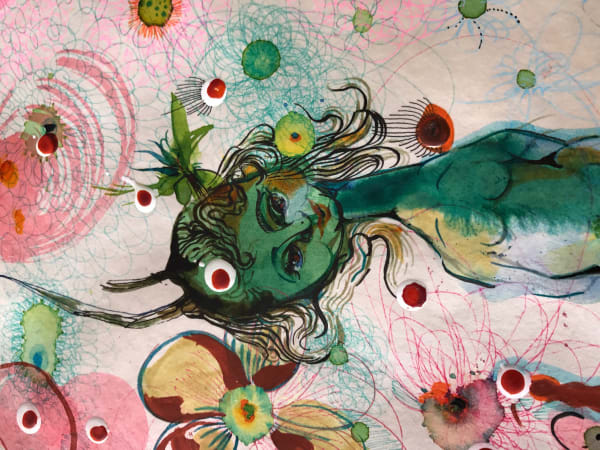Rina Banerjee, who was born in Kolkata, India and lives in New York, works with a cosmopolitan eclecticism that reflects both her transnational background and her sophisticated understanding of the narrative power of objects. Using trinkets made for the tourist trade — horn, bone, feathers, shells, textiles, glass bottles and antiques — she assembles rapturous sculptures that are mystifyingly shamanistic, yet overflowing with connotation. Her works are hyper-ornamented and lushly seductive. Conjoining rarities with cheap, mass-produced bric-a-brac, she appropriates extravagantly while rejecting hierarchies of material, culture and value.
In Banerjee’s paintings and delicate drawings on paper, female figures float in chimerical landscapes, often in states of transformation or with hybrid features of birds and beasts. Her titles are long, free-form refrains that immerse the viewer in the physical and emotional space of the work, heightening its quasi-mystical magnetism.
In a 2011 feature in Artforum, Banerjee describes the foundations of her work:
My mother told me that my first name is special because it is not typical in India—it is spelled differently. Hence, I was free to be what I wanted, or so I presumed. I was born in Calcutta, but I grew up in London and, then, New York, where I now live. Growing up abroad [as we called it] was a strange experience in the 1960s; there were so few Indians in the West. My parents saw themselves as international citizens. Maybe they imagined a future that we are just beginning to glimpse. I dream of this willingness to close the gaps between cultures, communities, and places. I think of identity as inherently foreign; of heritage as something that leaks away from the concept of home—as happens when one first migrates. Even my interest in science embodies an awareness of other worlds, worlds that coexist with us, but which we cannot experience or know. The sky, the stars, and the earth contain so much more than we think.
Freedom is the most expensive commodity; nature the most dangerous beauty. My work examines both. My art depicts a delicate world that is also aggressive, tangled, manipulated, fragile, and very, very dense.
-

Rina Banerjee
11 May - 29 Jun 2024Freedom wonders inside the fantastic, joyous, in relentless dreams free from constraints with movements wandering rotating entangled sinuous perpetual and glowing in effortless being and while wielding free will as...Read more -

Where We Are
23 Oct - 24 Nov 2021In a group exhibition marking this moment in history (and celebrating the 25th anniversary of Hosfelt Gallery) the work of 34 artists is employed to reflect on the zeitgeist of...Read more -

Rina Banerjee
Blemish 7 Sep - 12 Oct 2019Hosfelt Gallery presents a solo show of new mixed media paintings on paper by Kolkata-born, New York-based Rina Banerjee, as an ancillary exhibition to her touring mid-career survey, currently on...Read more -

BETWEEN THEM
An Installation Composed of Drawings 13 Jul - 17 Aug 2019Todd Hosfelt combines approximately 200 drawings in an installation designed to reveal thematic and conceptual relationships across time and place. In drawings spanning the 16th to 21st centuries, from European...Read more -

Frankenstein’s Birthday Party
23 Jun - 11 Aug 20182018 is the bicentennial of Mary Wollstonecraft Shelley’s novel, Frankenstein; or, The Modern Prometheus . Why does a 200-year-old ghost story continue to feel so relevant? It’s important to remember...Read more -

Rina Banerjee
Human Likeness 28 Jan - 4 Mar 2017Kolkata-born and New York-based, Rina Banerjee fills the entire gallery with her fantastical, immoderate sculptures and delicately swirling paintings in an exhibition that seeks to describe the human experience in...Read more -

20th Anniversary Exhibition
Banerjee, Campbell, Crotty, DeFeo, Hawkinson, Higgins, Kürten, Lukas, Maggi, O'Reilly, Ouadahi, Piccinini, Porter, Pwerle, Rath, Rodriguez, Schoultz, Wiley, Basquiat, Cave, Hansen, Ruscha, Sikander, and Wilke. 9 Sep - 8 Oct 2016Hosfelt Gallery celebrates its 20th anniversary with an exhibition exploring what makes an artwork significant and lasting, and the qualities that distinguish the most innovative artists of our era. This...Read more -

Holding It Together: Collage, Montage, Assemblage
12 Jul - 16 Aug 2014RINA BANERJEE, JAY DEFEO, TIM HAWKINSON, EMIL LUKAS, JOHN O'REILLY, PATRICIA PICCININI, LILIANA PORTER, ALAN RATH, ANDREW SCHOULTZ, WILLIAM T. WILEY, BRUCE CONNER, JEAN CONNER, JOHN ASHBERY, JOE BRAINARD, SARAH...Read more -

Rina Banerjee
Tender Mahal – Lifted 28 May - 13 Jul 2013For her first project at Hosfelt Gallery, Rina Banerjee brings together a monumental, pink, Mughal-inspired sculpture and a group of her delicate and sensuous paintings on paper, in a paean...Read more -

Look Both Ways
Banerjee, Campbell, Crotty, Danziger, DeFeo, Faruqee, Phungrasamee Fein, Haeckel, Hawkinson, Lukas, Maggi, O'Reilly, Ouadahi, Porter, Pwerle, Rath 8 Sep - 6 Oct 2012Hosfelt Gallery will inaugurate its new San Francisco venue with the group exhibition, Look Both Ways, opening at 260 Utah Street (at 16th Street) on September 8, 2012. Both a...Read more
-

Toward Freeing the Goddess from her Bodice
Rina Banerjee and Grace Yasumura, The Brooklyn Rail -

On View Now: Women Making Their Mark
Farah Abdessamad, Observer.com, November 27, 2023 -

Rina Banerjee in Elle Decor
Sean Santiago, Elle Decor, May 31, 2023 -

Rina Banerjee in Hyperallergic
Sanoja Bhaumik , Hyperallergic, May 25, 2023 -

Engaged Humanities Network Awards Grants to Faculty and Students for Collaborations With Syracuse Community
Dan Bernardi, Syracuse University, September 21, 2022 -

Art sans borders – RINA BANERJEE
Candice Yacono, The Shillong Times, January 16, 2022 -

E-Artist Conversation: Rina Banerjee and Kymberly Pinder
Yale University, November 12, 2021 -

10 Contemporary South Asian Artists You Must Know About and Support!
Nadia Schwingle, One Green Planet, March 11, 2021 -

50×50: Stories of Visionary Artists from the Collection – Rina Banerjee
San Jose Museum of Art, July 1, 2020 -

Rina Banerjee Assembles a Dazzling Diaspora
Shana Nys Dambrot, LA Weekly, December 26, 2019 -

Rina Banerjee and Lady Dior, from sculpture to miniature
Valérie Duponchelle, Le Figaro, November 29, 2019 -

'Rina Banerjee: Make Me a Summary of the World' Retrospective Travels to Fowler Museum at UCLA
ArtFix Daily, October 16, 2019 -

At SJMA, Rina Banerjee’s Retrospective Embraces a Fluid Complexity
Jeffrey Edalatpour, KQED Arts, September 6, 2019 -

Studio Visit: Rina Banerjee
Christie's, August 27, 2019 -

Forms of Exchange: Rina Banerjee Interviewed by Tausif Noor
Tausif Noor, Bomb Magazine, July 29, 2019 -

Rina Banerjee @ San Jose Museum of Art
Soraya Murray, Squarecylinder, June 4, 2019 -

Rina Banerjee
Hannah Stamler, Artforum, March 1, 2019 -

How Rina Banerjee Re-Routes Art History Through The Lens of Colonialism
Bea Huff Hunter, Frieze, February 19, 2019 -

An Interview with Rina Banerjee
Hadley Copeland, The Politic, February 4, 2019 -

Rina Banerjee, 'Make Me A Summary Of The World' At Pennsylvania Academy Of The Fine Arts
Clayton Press, Forbes, January 8, 2019 -

Imagining Utopia in Rina Banerjee’s Whimsical Cornucopias
Olivia Jia, Hyperallergic, January 4, 2019 -

Best of 2018
David M. Roth, Squarecylinder, December 22, 2018 -

Rina Banerjee at PAFA
Thomas Hine, The Philadelphia Inquirer, November 2, 2018 -

Indian-American artist to be featured in major exhibition in Philadelphia
Ela Dutt, News India, October 7, 2018 -

A Good Year for Younger Artists, Immigrant Citizens and Outrage
Holland Cotter, The New York Times, September 6, 2018 -

Frankenstein’s Birthday Party @ Hosfelt
Justin Manley, Squarecylinder, July 20, 2018 -

Summer exhibition at Hosfelt Gallery a monstrous affair
Charles Desmarais, San Francisco Chronicle, July 6, 2018 -

Kochi-Muziris Biennale in India Reveals Partial Artist List for 2018 Edition
Alex Greenberger, ARTnews, June 12, 2018 -

Pleasant Surprises in the Swamp at Prospect, the New Orleans Triennial
Paddy Johnson, Hyperallergic, November 22, 2017 -

Le materie vive di Rina Banerjee
Rai News, June 12, 2017 -

Avant garde techniques at Venice biennale
Agencies, Millennium Post, May 20, 2017 -

Artist in Residence
Koa Beck, Vogue, March 8, 2017 -

Rina Banerjee ‘Human Likeness’ at Hosfelt Gallery
Maddie Klett, Daily Serving, March 3, 2017 -

Rina Banerjee: reshaping reality into an alternative
Charles Desmarais, San Francisco Chronicle, February 17, 2017 -

10 Female Contemporary Artists From India To Know
C. A. Xuan Mai Ardia, The Culture Trip, September 12, 2016 -

The India Art Fair 2016 scorecard: spotlighting India’s great artists
Brittney, Art Radar, March 2, 2016 -

Art with Rina Banerjee
FWD Media, FWD Life, February 29, 2016 -

Gallery Chat: Technology Art Champion Todd Hosfelt Opens Innovative Digital Media Conservation Lab
Nicole Casamento, The ADAA, February 17, 2016 -

Sold out
Geetha Jayaraman, The Asian Age, February 2, 2016 -

Eye for expression
Geetha Jayaraman, The Asian Age, January 31, 2016 -

Strokes of Light and Shade
Pallavi Pundir, Vandana Kalra, The Indian Express, January 29, 2016 -

Vivacity
Arjita Mishra, The Daily Pioneer, January 29, 2016 -

Here’s what to look out for at the 8th edition of India Art Fair
Gargi Gupta, DNA India, January 24, 2016 -

See What ADAA Galleries Are Bringing to PULSE Miami Beach
The ADAA, November 25, 2015 -

At Greater New York, Rising Art Stars Meet the Old School
Holland Cotter, The New York Times, October 15, 2015 -

Suggestive sculptures that move by New York-based artist Rina Banerjee
Deepika Shetty, The Straits Times, February 3, 2015 -

“Disgust” at L.A. Louver
David Pagel, Los Angeles Times, May 14, 2014 -

Lordy Rodriguez & Rina Banerjee @ Hosfelt
David M. Roth, Square Cylinder, June 30, 2013 -

A Lingering Tour: Three Pieces Worth Spending Some Time With
Jonathan Curiel, SF Weekly, June 19, 2013 -

500 Words: Rina Banerjee
Zehra Jumabhoy, Artforum, June 22, 2011
-

Rina Banerjee at the San Jose Museum of Art
March 7, 2025Tending and Dreaming: Stories from the Collection launches the first dedicated collection galleries at the Museum. Providing unprecedented access to core works in San José's...Read more -

Rina Banerjee at the Asia Society Museum
March 4, 2025This exhibition reintroduces key works in Asia Society Museum's Mr. and Mrs. John D. Rockefeller 3rd Collection of pre-modern Asian art through the lenses of...Read more -

Rina Banerjee at the Smithsonian American Art Museum
November 8, 2024SAAM’s groundbreaking exhibition, featuring 82 artworks created between 1792 and 2023 , examines for the first time the ways in which sculpture has shaped and...Read more -

Rina Banerjee at the Museum of Contemporary Art San Diego
September 19, 2024For Dear Life: Art, Medicine, and Disability is the first exhibition to survey themes of illness and impairment in American art from the 1960s up...Read more -

HG Magazine Issue no. 37
Judith Belzer & Birgit Jensen exhibitions open, Publications, Museum Exhibitions March 17, 2022Opening March 26, 2022: Birgit Jensen: Enacting Arcadia Judith Belzer: Where We Stand Artwork Explained: Jay DeFeo Recent Publication: Liliana Porter Museum ExhibitionsRead more -

HG Magazine Issue no. 32
Judith Belzer joins the gallery; plus Rina Banerjee, Alan Rath, pi(e) July 20, 2021Introducing Judith Belzer Rina Banerjee & Rachel Kent: Conversation Recap An Artwork Explained: Alan Rath's Huge Pi 808 We Recommend: Pi(e)Read more -

HG Magazine Issue no. 31
Alan Rath exhibition opens; plus Rina Banerjee, Cornelius Völker, Nicole Phungrasamee Fein June 11, 2021Alan Rath opens June 19, 2021 Jim Campbell remembers Alan Rath Artist News: Rina Banerjee, Cornelius Völker New to Inventory: Nicole Phungrasamee Fein Whitney Museum...Read more -

HG Magazine Issue no. 29
Isabella Kirkland: THE SMALL MATTER & Patricia Piccinini: The Awakening open; plus Rina Banerjee on 8-Bridges, Cornelius Völker, biscuit recipe April 29, 2021Opening May 1: Isabella Kirkland: THE SMALL MATTER & Patricia Piccinini: The Awakening Rina Banerjee on 8-Bridges Art @ Home New to Inventory: Cornelius Völker...Read more -

HG Magazine Issue no. 27
Liliana Porter in the press & virtual event; plus Ben McLaughlin, Rina Banerjee, Isabella Kirkland, Patricia Piccinini, Max Gimblett, Lordy Rodriguez, Bruce & Jean Conner April 3, 2021Liliana Porter in Artforum and Artsy In Conversation: Liliana Porter & curator Humberto Moro Ben McLaughlin: Artwork Explained Art @ Home New to Inventory: Rina...Read more -

HG Magazine Issue no. 22
Remembering Alan Rath 1959-2020; plus Rina Banerjee, Driss Ouadahi, Jean Conner, Lordy Rodriguez November 12, 2020Todd Hosfelt's and David Roth's tributes to Alan Rath Rina Banerjee receives a Joan Mitchell Foundation Grant In the Studio: Driss Ouadahi and Jean Conner...Read more -

South East North West: New Works from the Collection
on view at the San Jose Museum of Art through September 19, 2021 October 30, 2020South East North West celebrates SJMA’s 50th anniversary with a dynamic presentation of paintings, sculptures, photographs, works on paper, and new media recently acquired by...Read more -

HG Magazine Issue no. 14
Driss Ouadahi in the studio; plus Crystal Liu, Rina Banerjee, Gideon Rubin, Tim Hawkinson July 29, 2020Watch Driss Ouadahi in his studio Crystal Liu in conversation with Abby Chen, Senior Associate Curator & Head of Contemporary Art at the Asian Art...Read more -

HG Magazine Issue no. 11
Art Basel OVR: Rina Banerjee, Patricia Piccinini & Liliana Porter; plus Andrew Schoultz & Jim Campbell film recommendations June 19, 2020Presenting work by Rina Banerjee, Patricia Piccinini and Liliana Porter in Art Basel's 2020 Online Viewing Room At the gallery: Andrew Schoultz Jim Campbell recommends...Read more -

HG Magazine Issue no. 10
The Art of Hanging; plus Lordy Rodriguez, Rina Banerjee, and Larry Rinder's book recommendation June 13, 2020Todd Hosfelt discusses his methodology for hanging artwork Lordy Rodriguez' Selma to Montgomery explained in depth We recommend a conversation between The Drawing Center’s Chief...Read more -

HG Magazine Issue no. 5
Rina Banerjee, Gideon Rubin, Rozzi Crane May 8, 2020Curator Betty Seid discusses Rina Banerjee’s traveling survey exhibition Make Me a Summary of the World at The Folwer Museum House and Garden UK feature...Read more -

Project Atrium: Rina Banerjee
on view at the MOCA Jacksonville through June 28, 2020 March 20, 2020Rina Banerjee is known for her large-scale sculptures and installations made from a wide range of materials that she brings together to raise questions about...Read more -

Rina Banerjee: Make Me a Summary of the World
on view at the Fowler Museum at UCLA through May 31, 2020 December 8, 2019Make Me a Summary of the World brings together several of Banerjee’s monumental installations in conversation with more than two dozen sculptures, as well as...Read more -

How the Light Gets In
on view at the Johnson Museum of Art through December 8, 2019 September 7, 2019The exhibition brings together an international group of artists and artist teams and collectives, ranging in age from their twenties to their nineties and representing...Read more -

‘I Like Drawings”: A Conversation with Todd Hosfelt
Squarecylinder August 5, 2019Drawing, as Hosfelt has envisioned it, appears to have the structure of a decentralized network, patterned through endlessly overlapping family resemblances without any single center...Read more -

Rina Banerjee: Make Me a Summary of the World @ SJMA
on view at the San Jose Museum of Art through October 6, 2019 May 16, 2019Rina Banerjee: Make Me a Summary of the World focuses on four interdependent themes in Banerjee’s work that coincide with important issues of our time:...Read more
-
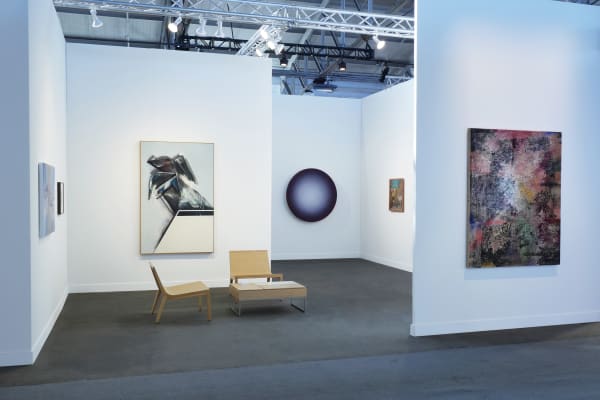
Fog Design + Art 2025
23 - 26 Jan 2025Artwork by San Francisco masters Bruce Conner, Jay DeFeo, Jess (Burgess Collins), and Wayne Thiebaud juxtaposed with works by contemporary artists Mansur Nurullah, Jutta Haeckel,...Read more -
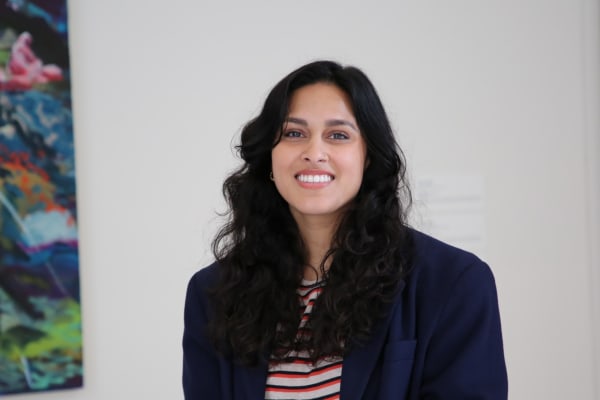
Nidhi Gandhi on Rina Banerjee
13 Jun 2024Nidhi Gandhi (she/her) is the Curatorial and Programs Associate at the San José Museum of Art. She received an M.A. in Art History from Williams...Read more -

In Conversation: Rina Banerjee & Rachel Kent
29 Jun 2021Rachel Kent, Chief Curator of the Museum of Contemporary Art in Sydney, Australia, interviews Rina Banerjee.Read more
-

Fog Design + Art 2025
23 - 26 Jan 2025Artwork by San Francisco masters Bruce Conner, Jay DeFeo, Jess (Burgess Collins), and Wayne Thiebaud juxtaposed with works by contemporary artists Mansur Nurullah, Jutta Haeckel,...Read more -
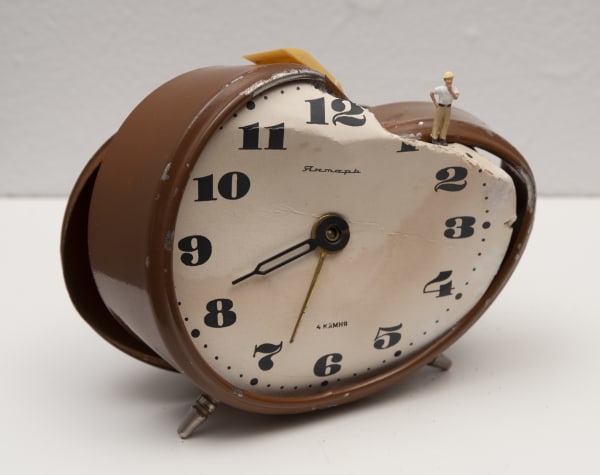
Art Basel
Rina Banerjee, Patricia Piccinini, Liliana Porter 17 - 26 Jun 2020Liliana Porter, Rina Banerjee and Patricia Piccinini - all immigrants to the countries in which they live and work and thus outsiders to one degree...Read more -
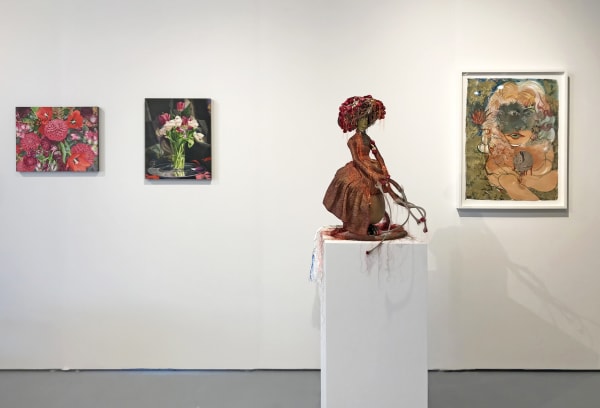
PULSE Miami Beach
6 - 9 Dec 2018Our PULSE Miami Beach 2018 booth selection highlights the wide range of our international program with artists from Australia, India, Uruguay, Argentina, England, and the...Read more -
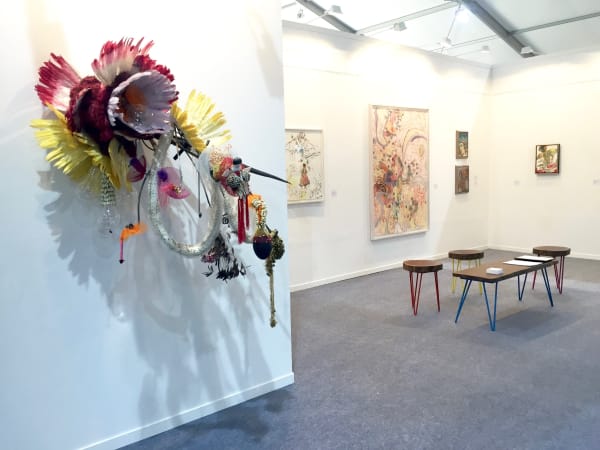
India Art Fair: Rina Banerjee
28 - 31 Jan 2016Hosfelt Gallery presents a solo installation of new sculptures, paintings, and works on paper by Rina Banerjee for its inaugural participation in the India Art...Read more

